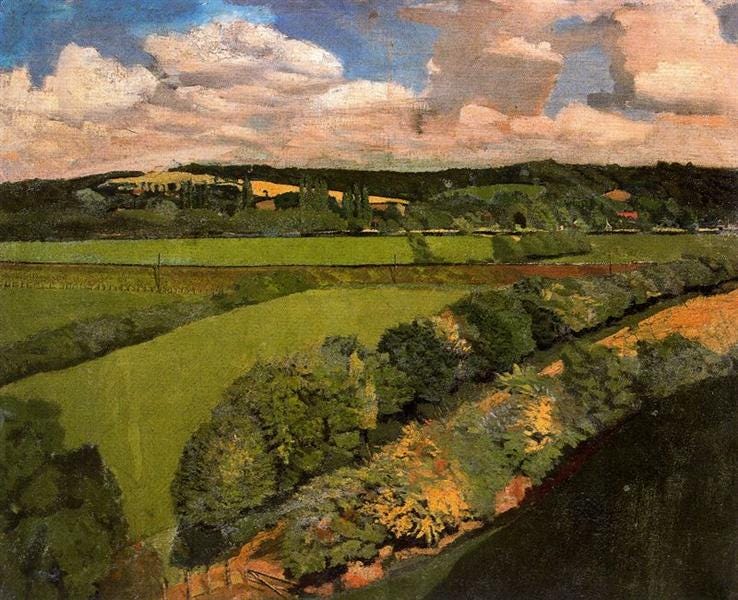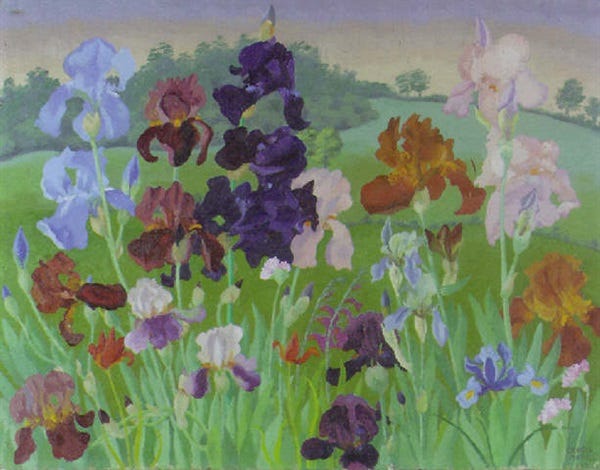Can you see what it is yet?
Reading Christopher Neve's Unquiet Landscape
Hi! I’m Hannah James, journalist, writer and editor, and this is where I review nature books, and think about nature-related topics out loud. Thanks for reading!
What I’m reading
In the 1960s, Christopher Neve was working at Country Life magazine in Covent Garden, teaching art history and doing his own painting. At the same time, he was researching Unquiet Landscape: Places and Ideas in 20th-Century British Painting.

Employed as Country Life’s art critic with only a single article to write each week (wow, I really did miss the golden era of magazines), he visited artists at their studios and in their homes, talking about art - and more often, about anything but art - with them, teasing out the subtleties of their philosophies, personalities, and working methods. The result of those years of conversation is this book, a series of essays that relate the work of about 20 early 20th-century artists to the ideas that animated that work, from lightheartedness (Eric Ravilious) and fruitfulness (Robin Tanner) to loneliness (L. S. Lowry) and death (Sheila Fell).
“It is a journey in the imagination through the English landscape, thinking in paint.”
So far, so art history. But.
Not only is Neve’s discussion of the ways in which painters approach landscape rich with deep insight, not only does he sketch vivid and delightful pen portraits of the artists he knew so well, not only does he explore complex ideas and philosophies, but he does it all in an impassioned, lively style that couldn’t be further from a dusty academic treatise. Neve’s writing is firm and opinionated, declamatory and vivid, laughing and bold, passionately questioning, with blood running strong through its veins. It’s strong meat and strong drink, colourful, rich and intoxicating.

In a chapter on Stanley Spencer called ‘The Need for Roots’, he writes:
“Have you known the life-long power of a place? Does a place have a hold on you?... How, if you do not know this, can I convey to you the depth and poignancy of the hold that Cookham had on Stanley Spencer?”
It feels almost shocking to be directly addressed in this way. It’s as close as a writer can get to shaking the reader by the shoulder and poking them in the chest, determined to make sure they’re listening and they understand. It’s as if you’ve been cornered at a party by a stranger, so you strap on your social smile and prepare to suffer, but instead, they regale you with juicy anecdotes combined with such deep wisdom you feel your mind expanding as you listen.
And this book has absolutely expanded my mind. Neve throws off his insights and moves swiftly on, but as the reader, you have to pause and ponder. Here he is (inevitably) on art:
“A picture is between a thought and a thing.”
“Paintings represent one moment, continually. That they are objects and not ideas is their strength and their limitation.”
“Part of the vitality of [Cedric Morris’s] landscapes derives from the fact that, in their awkwardness and vigour, they are almost disastrous. But does not good painting often seem to risk being bad?”

And on life in general:
“Often it is things we dread that most attract us.”
“I do not think that the difference between things is as great as it would seem. Shapes can become one another without the savour of distinction. The sea becomes the shore and, especially in mist or in too much light, water becomes the sky… if it were possible to see the world as all of a piece, it would offer a consolation.”
And of course his observations on what artists are trying to do when they paint landscape, what it means to them and what it means to us, the viewers, are solid gold:
“David Bomberg did not only respond to landscape: there is a fervent sense in which he became it.”
“The spirit in the mass. It should be what all great landscape painting is about…”
“The picture is its own country, a state of mind becomes a place.”

Yet for all his love of these paintings, Neve is deliciously rueful about the limitations of describing and analysing them in words:
“[David Bomberg] hated anyone writing about pictures, and who can blame him?”
“In an attempt to get at the truth I can all too easily end up writing nonsense.”
“You could say that this book is pointless.”
Yet it’s anything but. Why do artists contemplate a landscape, imbue it with their own perspective, and transfer it in paint to paper? And why do viewers study such paintings?
“To be rooted is a human need… To give your heart to a place to this extent means that you have given a part of yourself away and are no longer complete. But to scrutinise one place this hard is to make the world in some degree intelligible.”
This book is both a fireworks display and a serene sunset over the bay. I would like to read it forever.
Unquiet Landscape was book 49 for 2021. I’ve also been reading:
Adam Nicolson, Sissinghurst
Eileen Garvin, The Music of Bees
Pandora Sykes, How Do We Know We’re Doing It Right?
Tove Jansson, Sculptor’s Daughter
Thanks again for reading! Feel free to hit reply to this email to have a chat (I always write back!), press the heart button if you liked this, or comment.
Also! Follow me on Instagram @hannahjameswords, on Twitter @hannahjamesword and check out my website at hannahjameswords.com.


